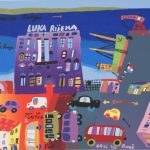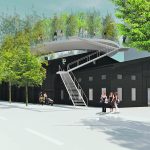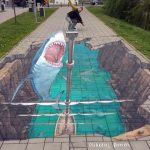Kristina Marić is a multimedia artist that was born in Đakovo in 1990. She graduated from the Art Academy in Osijek in the Department of Fine Arts and Multimedia in 2015. In 2013, Marić had a residence at the Art Quarter Budapest. She is the recipient of the Red Carpet Art Award for young artists in 2017. In 2018, she was a finalist for the Radoslav Putar Award from the Institute for Contemporary Art in Zagreb. Marić is a member of the Croatian Society of Fine Artists Osijek and is actively exhibiting at exhibitions and festivals in Croatia and abroad. Since 2016, she has worked as an assistant at the Academy of Arts and Culture in Osijek.
To begin, tell us which artists influenced you as an author since you’re active in many art forms (photography, performance, video installations, animations). What nudged you to take up arts?
This is probably the most frequently asked question to authors, and it is interesting how my answers to such general questions change over the years. If you go into the tale as a very young person, you are often led by emotions, and then come to the answers. I think it was an unconscious choice of the field of work in which I will more-or-less avoid the niches that society set up for me, which I got accustomed to since I was born. Even my choice of media expression reflects this. It’s hard for me to point out a name because I did not have those kinds of influences. There are really many artists that I adore, there were even some lecturers during my education who have done a number of small actions on my young brain and gave it a direction, encouraging it to continue listening to the same feeling it started with.
As a performer, you have a lot of works that got my attention, so-called Pičkin Dim (which saw a lot of buzz), On The Target, Into The Mud, Nici Kubik ( Nobody’s cubic meter). Please tell us more about these performances.
All of the works mentioned above are specific in their own way and are defined spatially and temporarily by their context of creation. To sum it all up, I think it is important to point out their critical nature towards the standard canon that marks our social environment and the overall climate we live in. Smoke was a direct reaction to the failures and absurd excuses of the local government for the firing of the director of Osijek’s museum. Later on, I used the motif of red smoke as an all-around sign of revolution. I turned that unimportant, silent and futile smoke into that series into a place that, from the viewpoint of a single person, alludes to the position of the artistic craft in (Croatian) society.
As a photographer, you also have a lot of works (I’d like to point out the video Escape, Dvoboj (Duel) and the interactive computer-installation Traces). Tell us more about them, do they have a hidden message?
I think that it is wrong to talk about hidden messages in the context of art, at least when talking about my work. That would imply the action of hiding. I like to think about my work as using the method of unravelling. The messages are mostly expressed in a way open enough to enable the viewer to fill it up, but only if he wants to. When reading on their own, they can have multiple interpretations, but it seems to me that, when connected with previous works, the interpretations become more material. In the photography series Tracks, I imprinted everyday items in the skin, playing with the ability of skin to erase experiences, even those that at first glance seem red, deep and painful.
You have won countless prizes, among which are the Radoslav Putar prize and a trip to New York awarded by the Institute of Modern Arts. Which of your works won the prize?
The entrance to the final of Radoslav Putar was the greatest acknowledgement of that kind for my work. Being in the company of great colleagues was a wonderful and educational experience.
In addition to the fields above of art, you also delved into animation and volunteered during the BAF (Baranja Animation Festival), an international festival of short animation. Can you tell us more about BAF and your animated works?
I worked with stop-motion (an animation technique that was used so that a certain object appears to be moving all on its own) in some of my video works and a pedagogical sense through courses for kids. I held my first course of that kind during BAF. Sadly, BAF is a cancelled festival. Despite the great initiative of a few enthusiasts, the project is cancelled.
In addition to arts, I noticed that you’re very active in sports – you won one bronze medal in cross-racing, and you’re an avid bicyclist. What other activities do you take aside from sports and, of course, art?
I’ve been a recreational athlete from an early age. The mentioned medal is from my high school days. It is a small feat, but very dear to me. I grew up in a family where health and physical fitness are highly valued, so that these trending menus, nutritional recommendations, tips from trainers etc. are simply something I was used to from an early age. I combine various activities, depending on what my body asks for at the moment, from low to very high-intensity activities, so that I can keep balance, which I consider very important, especially when the working time gets very exhausting.
To conclude, what are your plans, performances? I know that you were in Split to introduce the installation Dvoboj (The Duel). Will we see you again?
I am currently preparing for a two-month long residential stay in Lithuania for which I, of course, have plans. But I also try to keep my options open and do new projects. After an intensive lecturing time this year, in which I also include my exhibition in Split, comes the time for the realization of works waiting for their turn. Because of work, I think that most will have to wait until the residence to see the light of day.
Interview sourced from Solin Live.
To read more about lifestyle in Croatia, follow TCN’s dedicated page.










